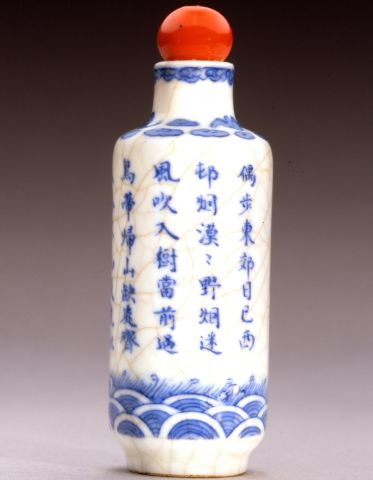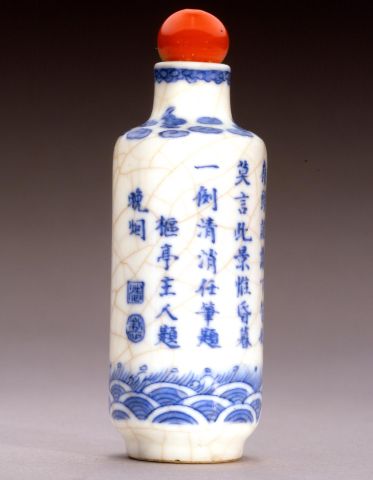

Bottle ID: 328
BLUE UNDERGLAZE, CYLINDRICAL WITH POEM
Date: 1820-1880
Height: 71 mm
Porcelain, soft paste, with a transparent glaze on cobalt oxide, of cylindrical form with a recessed cylindrical foot; inscribed in underglaze cobalt blue with a poem titled wan yan (“Evening Mist”), above a formalized wave pattern border at the foot, and below a cloud pattern border with three flying bats on the shoulders beneath a lingzhi fungus head band at the neck; the foot and interior glazed, signed Shuting Zhuren, inscribed on "Evening Mist". The poem reads:
By chance I stroll in the eastern outskirts,
when the sun is already in the west;
Village smoke lies dense and quiet,
mists in the outlands confuse me;
A breeze blows it into the trees,
and it passes right in front of me;
Birds take it back to the mountains,
and it breaks off in an even line.
Beyond the sky they cannot know
what the autumn here is like;
Upon the ridge, who could conceive
that they are above a place so low?
Don't say this scene happens
only at dusk and evening.
For any and all pure enjoyments
I let my brush inscribe as it will.
Attributed to Jingde zhen.
Similar Examples:
Kleiner, Robert. In Search of a Dragon: Underglaze-Blue and White Porcelain Snuff Bottles from the Collection of Joseph Baruch Silver, 2007, p. 143, no. 104.
Provenance:
Clare Lawrence Ltd.
Sotheby's, New York, March 17, 1997, lot 388
The Canadian Collection
A group of similar underglaze blue porcelain bottles exist which are clearly inspired by matched sets of Imperial porcelain of trays, teapots and tea bowls with lines of calligraphy on the exterior surfaces produced in the Palace kilns at Jingde zhen in the eighteenth century. One known set was made to celebrate the Qianlong Emperor's birthday in 1746. The Jiaqing Emperor also commissioned a set to be made for his birthday in 1797. Whilst the majority of the porcelain snuff bottles are produced from hard paste porcelain, this example is unusual in the use of soft paste porcelain. Soft paste porcelain bottles seem to be generally of a higher quality both in terms of the potting and the underglaze blue decoration as the cobalt oxide seems to spread less during the firing, a crucial feature when calligraphy is the main element of the design.
The poem is not recorded in the standard sources, however three possible poets have emerged, thanks to Hugh Moss's research. It seems most likely that Shuting may have been Wu Shiwan, a native of Fujian and a Jinshi. He was noted as being both honest and poor, dying on the way to his last appointment. One of his daughters-in-law preserved his poems. It is not certain that this poem was written by him, although the style and subject matter is similar to his recorded poems.
The second possibility is a published, but little known, poet named Deng Shuting, from Dacheng in Hebei Province. His poetry collection was acsribed to the third possibility, Liu Shuting, of whom even less is known.

 English
English 中文
中文